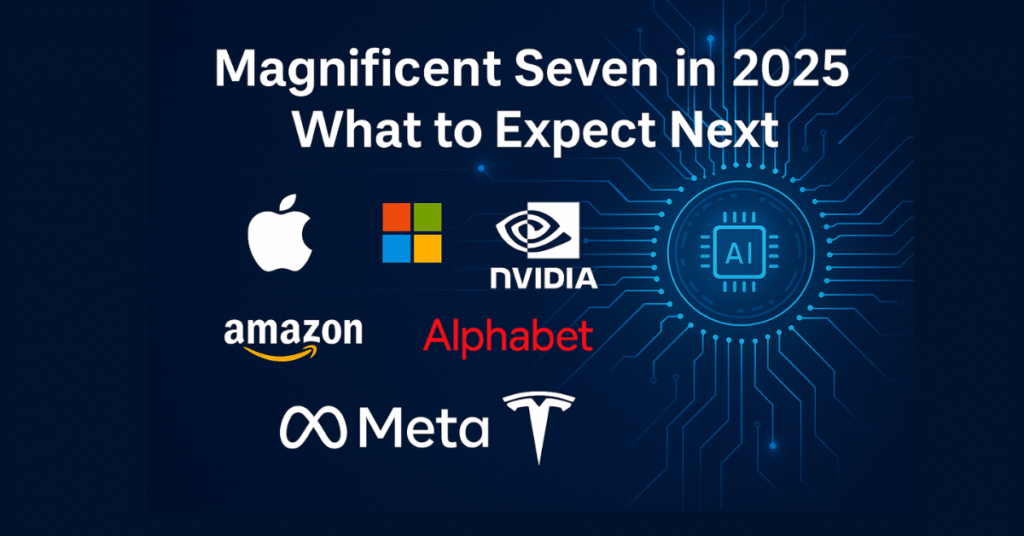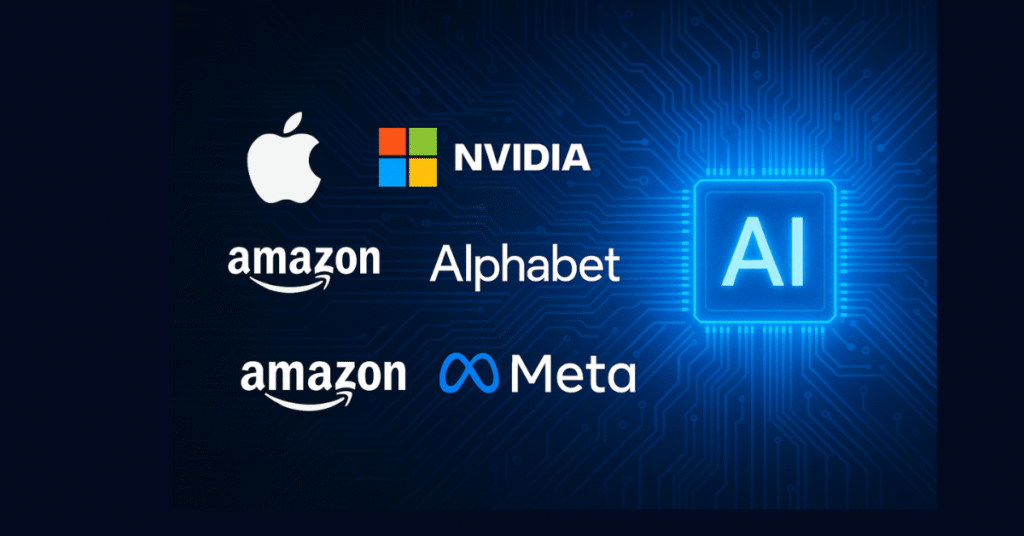
The second half of 2025 may bring both opportunities and challenges for the tech giants known as the Magnificent Seven in 2025. Analysts believe these companies—especially those leading in AI innovation—will keep gaining from their massive scale and dominant market presence. But they also caution that the pace of earnings growth could slow, and investors may start eyeing other sectors for better returns.
- Three of the Seven Are Flying High
- The Journey So Far: How We Got Here-Magnificent Seven in 2025
- Second-Half Challenges & Growth Drivers
- Conclusion: Opportunity Meets Caution-Magnificent Seven in 2025
- Disclaimer
Three of the Seven Are Flying High
Nvidia, Microsoft, and Meta have all posted double-digit gains so far in 2025. They’re now trading near or at record levels. Meanwhile, Amazon and Alphabet are just shy of their peaks. But Apple has dipped by 14%, and Tesla has fallen by 19% year-to-date.
The Journey So Far: How We Got Here-Magnificent Seven in 2025
The Magnificent Seven in 2025—Apple, Microsoft, Nvidia, Amazon, Alphabet, Meta, and Tesla—started 2025 strong, riding a wave of AI excitement. The past two years have seen their stock prices soar, thanks largely to advances in artificial intelligence.
The rally also got a boost from early optimism about President-elect Donald Trump, whose policies were seen as business-friendly—tax cuts, deregulation, and open-door support for corporations.
Tesla was expected to gain the most, especially with Elon Musk’s close ties to the new administration. But the opposite happened. Tesla’s sales fell sharply, and its stock slumped amid backlash over Musk’s political role.
Adding to the turbulence, Trump’s tariffs created panic across Wall Street, hitting tech stocks hard. The Roundhill Magnificent Seven ETF (MAGS) plunged over 30% from its December highs. However, things have since bounced back. With trade tensions easing, the U.S. economy staying strong, and core businesses remaining solid, the ETF turned positive in the second quarter of 2025.
Magnificent Seven in 2025
| Company | YTD Performance (%) | Trading Status |
|---|---|---|
| Nvidia | +52% | Near all-time high |
| Microsoft | +36% | Record territory |
| Meta | +28% | At peak levels |
| Amazon | +9% | Slightly below record |
| Alphabet | +7% | Slightly below record |
| Apple | -14% | Underperforming |
| Tesla | -19% | Major correction |
Second-Half Challenges & Growth Drivers
As we move into the latter half of the year, the tech giants are facing both headwinds and tailwinds.
1. AI Investments Still Going Strong

Early in 2025, there were concerns that AI spending might slow. China’s DeepSeek introduced a more efficient AI model, raising doubts about whether companies really needed to boost computing power so aggressively.
Add to that the pressure from Trump’s sweeping tariffs, which raised fears of a stagflation period—where inflation remains high while growth slows. Despite these concerns, hyperscalers like Microsoft, Amazon, Alphabet, and Meta continued to spend heavily.
Collectively, these companies are expected to pour over $300 billion into infrastructure this year—most of it going toward data centers and tools to power AI models. This continued investment is great news for suppliers like Nvidia, Broadcom (AVGO), and Arista Networks (ANET). Other beneficiaries include Amphenol (APH) and Coherent (COH), which supply networking and semiconductor gear.
2. Earnings Growth Might Cool Off
Over the past two years, the Magnificent Seven have been the main engine of S&P 500 earnings. In Q1 2025, they saw profit growth of about 28%, compared to just 9% for the rest of the index.
That gap, however, has been narrowing. In Q2 2024, the difference was nearly 30 percentage points. Now, it’s around 19 points, and FactSet expects both groups to be on par by early 2026.
Still, analysts admit they’ve often been too optimistic in predicting when the rest of the market will catch up. So, a surprise could be in store again.
| Quarter | Mag 7 Earnings Growth | Rest of S&P 500 |
|---|---|---|
| Q2 2024 | 30% | 3% |
| Q1 2025 | 28% | 9% |
| Q1 2026 (Est.) | ~13% | ~13% |
3. Size and Strength Can Shield Against Volatility
In uncertain times, size matters. Analysts suggest that the sheer scale and financial strength of these tech leaders may help them weather any shocks from tariffs or economic slowdowns.
According to Janus Henderson, U.S. earnings for Q2 may dip due to trade worries but could rebound later in 2025 as companies adapt.
Companies with solid balance sheets, pricing power, and flexible supply chains—like those in the Magnificent Seven—should be more resilient.
JPMorgan warns that if growth remains sluggish and interest rates stay high, markets might once again concentrate around a few dominant names—just like we saw in 2023–2024.
4. The AI Boom Is Spreading
Until now, the AI story has mostly revolved around the Magnificent Seven. But that’s changing.
JP Morgan believes we’re entering a phase of broader AI adoption. Sectors like semiconductors, data centers, cybersecurity, and power infrastructure are all poised to benefit.
Still, the tech giants remain investor favorites. Citibank says their top AI picks are the hyperscalers—especially Microsoft—and data-focused companies like Snowflake (SNOW) and MongoDB (MDB).
They also highlight firms using AI to improve operational efficiency. For instance, Cyberark (CYBR) in cybersecurity and Monday.com (MNDY) in productivity tools are being recognized for their smart use of AI to create value.
Key Takeaways:–Magnificent Seven in 2025
- Nvidia, Microsoft, and Meta are thriving.
- Apple and Tesla are under pressure.
- AI spending remains a strong tailwind.
- Earnings growth will likely moderate.
- New players are entering the AI spotlight.
Conclusion: Opportunity Meets Caution-Magnificent Seven in 2025
In the second half of 2025, the Magnificent Seven will likely remain central players in the market—but not without risk.
High valuations, global tensions, and trade disruptions are real threats. Still, their massive cash reserves and leadership in AI could help them push forward.
Yet, investors should also watch for emerging players in the AI space, as the next wave of growth may come from beyond the Big Seven.
Disclaimer
This article relies on internal data, publicly available information, and other reliable sources. It may also include the authors’ personal views. However, it’s essential to note that the information is for general, educational, and awareness purposes only—it doesn’t disclose every material fact. This analysis is for informational purposes only and does not constitute financial advice. Consult a professional before making investment decisions.
We publish information on World Virtual CFO in good faith, solely for general information. World Virtual CFO doesn’t guarantee the completeness, reliability, or accuracy of this information. These are our views for informational purposes. When you use our website, know that any action you take is entirely at your own risk. World Virtual CFO won’t be liable for any losses or damages connected to your use of our website. For detailed information, refer to our disclaimer page.
Dr. Dinesh Sharma is an award-winning CFO and AI strategist with over two decades of experience in financial leadership, digital transformation, and business optimization. As the founder of multiple niche platforms—including WorldVirtualCFO.com—he empowers professionals and organizations with strategic insights, system structuring, and innovative tools for sustainable growth. His blogs and e-books blend precision with vision, making complex financial and technological concepts accessible and actionable.